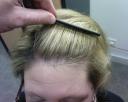Use of Finasteride to Prevent Hair Loss Presents a Problem for Professional and Olympic Athletes
10.04.2008 in UncategorizedChoosing Between Doing Their Best and Looking Their Best
Male athletes who aspire to peak performance in competition are also often men who want to present the best possible personal image in public. In the equally competitive marketplace of media appearances and product endorsements by athletes, an image of youthful vigor is most likely to attract sponsors.
Many male athletes are now finding that they cannot qualify for competition in professional or Olympic sports if they also use a highly successful medical treatment for hair loss. The ability to compete and the prevention of progressive balding are incompatible.
The widely disseminated and subscribed World Anti-Doping Agency (WADA) bans the use of the hair-loss treatment finasteride (Propecia®) by competing athletes. The WADA Code is accepted and followed by many professional leagues and teams in a variety of sports, as well as by the International Olympic Committee. A number of professional athletes have been banned from playing in their sports when finasteride was detected in urine samples they provided for “anti-doping” tests.
While finasteride is not, in itself, a performance-enhancing substance, it is known to be a “masking agent” for a number of performance-enhancing steroids banned by WADA. The performance-enhancing steroids are in the class known as anabolic androgenic steroids, which includes the “male hormone” testosterone. Finasteride inhibits the activity of an enzyme that converts testosterone into a form that is metabolically active in hair follicles.
The presence of finasteride metabolites in the urine makes it difficult to impossible to detect the presence of a number of the performance-enhancing steroids banned by WADA.
Studies with volunteers have shown that the presence of finasteride in the blood and urine changes the metabolic profile of some banned steroids. Urinary excretion of some banned steroids is decreased in the presence of finasteride, while urinary excretion of others is increased. The changes in urinary excretion profiles could be detected for longer than eight days after a 1 milligram or 5 milligram dose of finasteride. When finasteride is taken to prevent hair loss, it is taken as a 1 milligram pill once a day.
Investigators who conducted one of the studies noted that the use of finasteride to prevent hair loss may cause serious problems when anti-doping officials try to interpret the results of tests for banned steroids. It may also be difficult to determine whether an athlete used finasteride without knowledge of its steroid “masking effect”, or deliberately in an effort to escape detection of the use of a banned substance.
Finasteride, the WADA Code, and Athletes
The World Anti-Doping Agency (WADA) Anti-Doping Code is an international standard accepted internationally by professional sports teams and their leagues, and by the International Olympic Committee. It is updated annually as testing methods improve and as more substances are identified as performance enhancers.
The “finasteride problem” has tripped up a number of male athletes (the use of finasteride by females is discouraged due to possible effects on an embryo or fetus). Some of the athletes did not know there is a “finasteride problem” until it put them at risk of being rejected for competition.
Zach Lund, a member of the U.S. skeleton team at the 2006 Winter Olympics, was banned from competition after finasteride was detected in his anti-doping urine sample. Lund said he had no intention of providing a faulty urine sample when he took finasteride as a hair loss treatment. The Court of Arbitration for Sport (CAS) agreed that Lund had not tried to cheat the WADA Code; nevertheless, Lund was banned from competition.
Montreal hockey goal tender Jose Theodore had been taking finasteride for eight years as a hair loss treatment-then found out about the “finasteride problem” when he tested positive for the substance in screening of athletes who hoped to compete in the 2006 Winter Olympics. Finasteride is a banned substance under the WADA Code, which is accepted by the International Olympic Committee. He had been taking finasteride with the knowledge and approval of team physician Dr. David Mulder. The positive test resulted in no disciplinary action because testing for finasteride is not included in the National Hockey League’s anti-doping testing program.
Efforts are underway to develop a test that would selectively identify finasteride in a urine sample. Such a test could eliminate finasteride as a problem in anti-doping testing.
What is Finasteride?
Finasteride is a potent inhibitor of the enzyme 5-alpha-reductase Type 2. The enzyme converts the anabolic steroid testosterone into 5-alpha-dihydrotestosterone, an androgen regulating factor in the hair follicle. Increased activity of the enzyme 5-alpha reductase leads to increased concentration of 5-alpha-dihydrotestosterone. This increased concentration of the testosterone metabolite results in a shortening of the anagen-telogen-catagen hair cycle in hair follicles that are sensitized to the activity of 5-alpha-dihydrotestosterone by genetic predisposition.
Most hair loss in men is due to genetically-predisposed male pattern hair loss, also known as androgenetic alopecia. The shortened hair cycle eventually results in the transition of hair from “normal” to “vellus”-a fine, “peach fuzz” hair-and finally to total loss of hair from the affected follicles.
The enzyme 5-alpha-reductase is present in the body in two forms–Type 1 and Type 2. Type 1 is found mainly in sweat glands and hair follicles, Type 2 in prostate tissue and hair follicles.
Do you have Hair Loss Problems, read our Hair Loss Help
no comment











